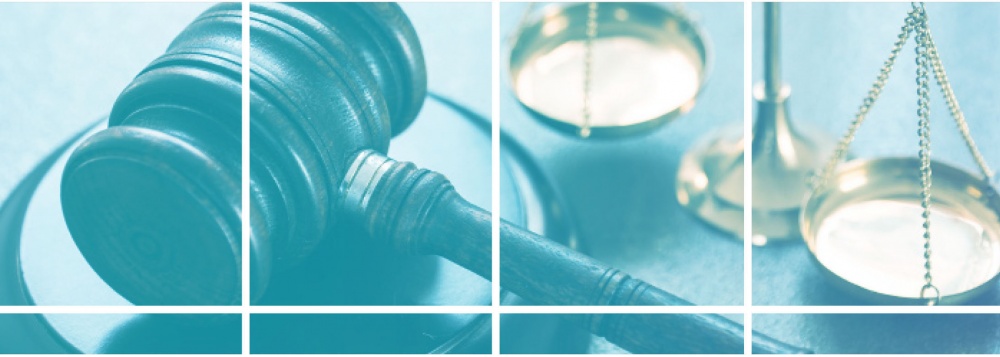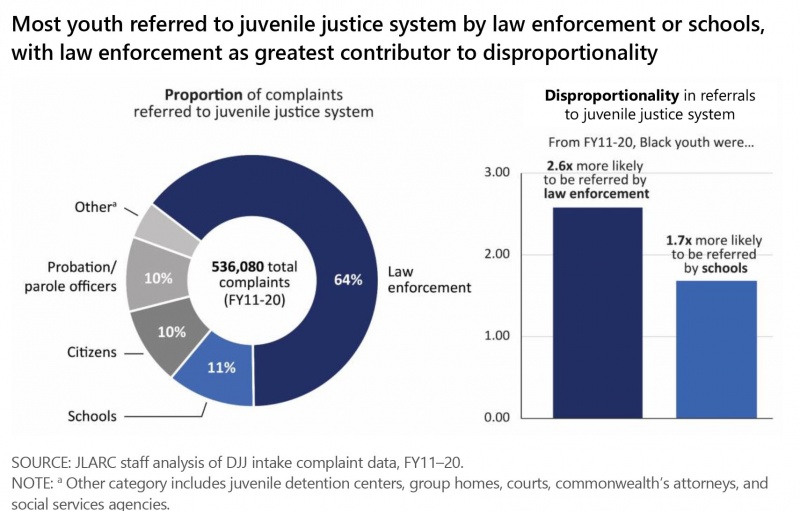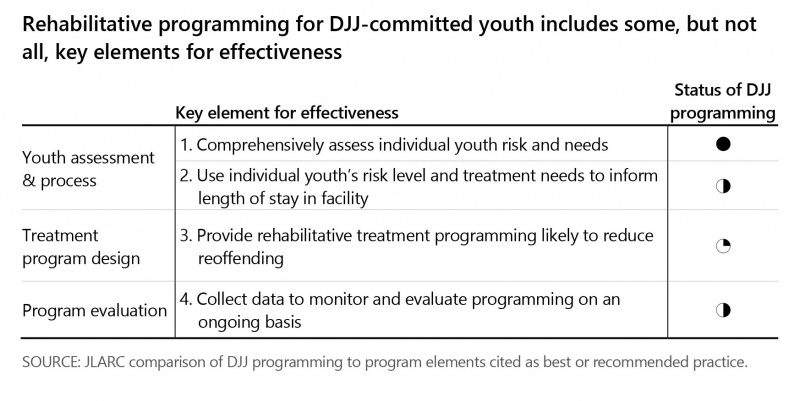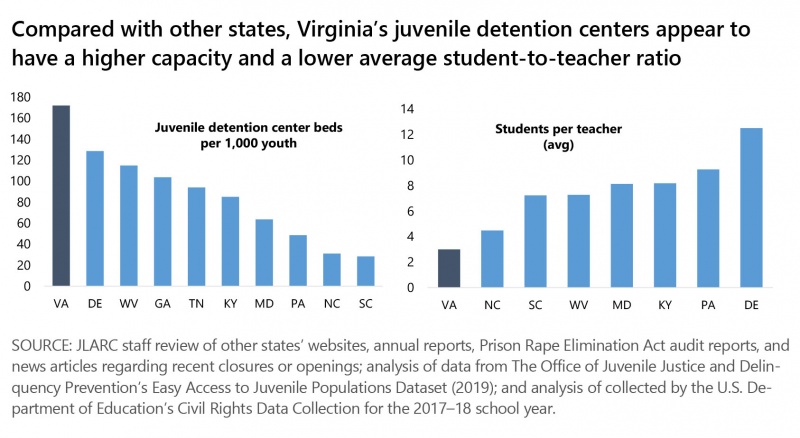Virginia's Juvenile Justice System

WHY WE DID THIS STUDY
In November 2020, the Joint Legislative Audit and Review Commission (JLARC) directed its staff to review Virginia’s juvenile justice system.
ABOUT JUVENILE JUSTICE IN VIRGINIA
Virginia’s juvenile justice system exists to respond to allegations of illegal acts committed by youth. The Department of Juvenile Justice (DJJ) is primarily responsible for administering and overseeing juvenile justice services. DJJ operates 30 of 32 court service units (CSUs) and the Bon Air Juvenile Correctional Center. Localities also operate 24 juvenile detention centers (JDCs). About 3,000 youth are involved in the juvenile justice system, most of whom are in the community on a diversion plan, probation, or parole. About $250 million state and federal funds were spent on juvenile justice services in FY20.
WHAT WE FOUND
Far fewer youth are in Virginia’s system because of several factors
There are 70 percent fewer youth in Virginia’s juvenile justice system than a decade ago (9,551 in 2011 to 2,980 in 2021). This decline of youth in Virginia ’s system is at least partially attributable to several factors , including a decline in youth arrests and complaints and DJJ’s transformation efforts. The decline in Virginia is consistent with national trends.
Recidivism has improved for lower risk youth but remains about the same for higher risk youth
There is a promising reduction in recidivism among lower risk youth, which may be partially attributable to DJJ’s transformation efforts. For example, two-year rearrest rates declined from 23 percent to 19 percent between
FY15 and FY19 among youth who successfully completed diversion plans and from 49 percent to 44 percent between FY15 and FY19 for youth who were released from probation.
However, the COVID-19 pandemic makes it difficult to reach definitive conclusions about the sustainability of the decline in any reconviction or rearrest rates. Referrals from law enforcement dropped by 41 percent between FY20 and FY21 , which was by far the steepest decline in referrals from law enforcement over the past decade.
Recidivism among high risk youth released from DJJ custody has remained about the same. Two-year rearrest and reconviction rates for youth released from secure residential facilities (i.e., juvenile detention centers or juvenile correctional centers) have remained stable or have shown no clear pattern over the last five years.
Not all youth receive quality legal representation, particularly those represented by court-appointed attorneys
All youth have access to an attorney as required by law, but stakeholders, including judges and attorneys, expressed serious concern about the quality of representation some youth receive. Stakeholders noted that many attorneys do not adequately understand juvenile law or spend enough time with their clients. As one judge lamented, "We have plenty of attorneys. We have enough attorneys to get us by. What we don’t have are quality attorneys.”
Inadequate representation appears to be most prevalent among court-appointed counsel and is at least partially due to low compensation and insufficient training. Virginia’s compensation for court-appointed attorneys is lower than other states. Required training is minimal and does not sufficiently address key topics, such as the intake process
and detention hearings.
Black youth are more likely than white youth to be referred to Virginia’s juvenile justice system
During the last decade, Black youth were about 2.5 times more likely than white youth to be referred to the juvenile justice system. This trend holds true for all types of offenses (e.g., felonies, misdemeanors, status offenses, etc.). Law enforcement refers the majority of complaints to the system, and the racial disproportionality is greatest for these referrals (figure). Racial disproportionality in referrals was found in each of the state’s 34 court service unit (CSU) districts, but the rate of disproportionality in referrals varied across the state.

Juvenile detention centers meet safety and security standards but appear ill equipped to provide fully effective rehabilitative programs
Youth in juvenile detention centers (JDCs) appear to be in a relatively safe and secure environment. Through its oversight, DJJ uses a standardized approach, as required, to ensure JDCs meet statutory and regulatory requirements for security, health, and safety. DJJ conducts on-site certification audits during a two- to five-day period, at least once every three years.
However, high recidivism rates among youth released from JDC rehabilitative programs indicate that these programs are not particularly effective at reducing the likelihood that youth reoffend. The majority (68 percent) of youth released from a JDC rehabilitative program between FY16 and FY18 were reconvicted within two years. The majority of these reconvictions occurred within the first year of a youth’s release.
Many JDCs do not appear to provide rehabilitative programming that research indicates is effective, which could contribute to high recidivism rates. Only five JDCs reported using programs that have been assessed and found to be effective for youth in residential settings. Eleven JDCs reported not using evidence-based programming to reduce recidivism and not evaluating the effectiveness of their programming on reducing recidivism.
Educational programming in JDCs misses opportunity to provide instruction during the summer, and gaps exist in vocational programs
The adherence to a traditional school year precludes JDCs from providing educational programming to youth during the summer. Youth in JDCs, many who are already academically behind their peers not in the juvenile justice system, would benefit from remedial or other educational programming during the summer. According to the National
Institute of Corrections, “educational services should occupy the maximum amount of time allowed” and that “a detention education program should operate on a 52-week schedule.”
According to a recent Virginia Detention Association of Post-Dispositional Programs survey of 18 JDCs, 14 facilities reported offering vocational training services—with eight offering career education services and 10 offering specific trade and/or certification trainings. Nearly all JDCs (22 of 24) reported that increasing the availability of vocational training services for youth in their facilities would help reduce recidivism.
DJJ’s rehabilitative programming is less than fully effective and unlikely to reduce reoffending
The rehabilitative programming provided at Bon Air Juvenile Correctional Center includes some effective elements. For example, DJJ currently conducts risk and needs assessments for youth using the Youth Assessment and Screening Instrument (YASI), which research indicates accurately identifies risk factors that are predictive of
reoffending. DJJ has also designed its own sex offender treatment program, which uses a comprehensive approach to addressing youths’ identified risk factors.
However, DJJ’s current approach to rehabilitative programming at Bon Air JCC does not appear to maximize its ability to reduce recidivism. The two primary rehabilitative programs used for most youth (85 percent) appear unlikely to reduce reoffending based on existing data and research. Additionally, DJJ’s current approach to determining length of stay for indeterminately committed youth may be undermining its rehabilitative
goals. DJJ could also better leverage its strong data capabilities to evaluate and improve the effectiveness of its rehabilitative programming for youth committed to its custody.

Additionally, training for front-line Bon Air staff known as residential specialists has yet to reflect the full scope of their new responsibilities, and DJJ is having increasing difficulty recruiting and retaining staff for the job. For example, residential specialists have had therapeutic responsibilities since 2017, but training standards for these staff still did not reflect these new skills as of December 2021. In addition, nearly 35 percent of the 248 residential specialist positions were vacant as of October 2021, and turnover in the position was 27 percent in FY21.
DJJ’s re-entry efforts have improved, but youth released from custody still face barriers to successful re-entry
DJJ takes some important and appropriate steps to plan for and facilitate youths’ reentry into the community after they are released from DJJ custody. For example, each youth has a treatment team that develops the youth’s re-entry plan upon admission to DJJ custody. Preliminary data suggests educational outcomes are improving for youth at Bon Air JCC. In addition, family engagement, a key factor in successful re-entry, has improved recently at Bon Air JCC, and this is likely attributable to DJJ’s recent reforms, including its free transportation program to help families to visit youth.
Despite progress in re-entry efforts, there are not enough step-down opportunities for youth in DJJ custody. Step-down opportunities can include both housing and other programming, such as short-term furloughs or work release programs. Because stepdown housing opportunities are not widely available, they are offered only to youth who do not have other options for living arrangements upon release.
Virginia does not expunge or seal the felony equivalent records of juveniles adjudicated in juvenile and domestic relations district court, which can be a barrier to youth seeking educational and employment opportunities after release. Retaining felony equivalent records grants prospective employers and educational institutions potential
access to these records. Requiring these records to be made available for all felony adjudications appears inconsistent with the juvenile justice system’s goals of rehabilitation. It is also inconsistent with how other states treat juvenile records and Virginia’s recently amended law for adult records.
JDCs have far too much capacity, and majority of JDCs are not implementing educational efficiency strategies
Though JDCs are local or regional facilities (not state facilities), the state pays about one-third of JDC operation and maintenance costs and 100 percent of JDC education costs. State spending on JDCs totaled about $74 million in FY20 and was the largest state juvenile justice expenditure that year. The state spent $25 million on education at
JDCs, resulting in spending per student ranging from $23,000 to $88,000.
JDCs have not reduced their capacity as the number of youth in the system has declined, and most have not implemented strategies to provide education more efficiently. Only about 30 percent of Virginia’s JDCs’ capacity is currently being used, and Virginia JDCs have more beds than any other state in the region. Additionally,
Virginia JDCs appear to employ substantially more teachers per student than surrounding states, and the majority of JDCs report not implementing strategies that could improve efficiency, such as sharing teachers or using part-time staff.

Bon Air Juvenile Correctional Center should be replaced with smaller facilities, but full needs are currently unclear
Bon Air Juvenile Correctional Center (Bon Air JCC) is not ideal for effective rehabilitative programming for several reasons: its size, its distance from youths’ home communities, and its lack of appropriately designed treatment space. The Bon Air JCC appears to be among the largest secure juvenile facilities in the region and nationally, and was not designed to support effective rehabilitative programming. Although DJJ’s free transportation program mitigates the costs incurred by families to visit youth at Bon Air JCC and appears to have resulted in greater levels of family engagement, it can take families considerable time and effort to travel to and from the facility.
Stakeholders generally agree that the Bon Air facility is not adequately meeting the needs of committed youth and should be replaced. However, there is disagreement on the size, number, and locations of future secure treatment facilities. Replacing the oversized and aging Bon Air facility and building several other small facilities around the state would more closely align with national best practices, but the construction and operation of multiple smaller facilities would require considerable additional resources. DJJ should transition to a new, smaller treatment-oriented facility on the Bon Air JCC campus and not wait for the size, number, and location of other facilities to be determined.
WHAT WE RECOMMEND
Legislative action
- Increase the maximum compensation for court-appointed attorneys in juvenile delinquency cases.
- Direct the Virginia Indigent Defense Commission to strengthen training requirements for court-appointed counsel in juvenile delinquency cases.
- Require the Department of Criminal Justice Services to expand training standards for law enforcement to address implicit bias, cultural diversity, and protective responses when interacting with juveniles.
- Require juvenile detention centers providing post-dispositional rehabilitative programming to youth to provide evidence-based programs and services to the maximum extent practicable.
- Direct VDOE to develop a plan for an extended school year model that provides structured summer programming in juvenile detention centers.
- Direct VDOE to convene a workgroup to assess and improve the adequacy of current training, certification, and placement assistance services available in juvenile detention centers.
- Direct DJJ to provide rehabilitative treatment programs based on the best available evidence of effectiveness at reducing the likelihood of reoffending for youth committed to secure residential settings.
- Establish a process to allow records for certain less serious, non-violent felony equivalent offenses for youth adjudicated delinquent in juvenile and domestic relations district court to be automatically sealed after a period of
years specified by the General Assembly up to age 29, and then subsequently expunged. - Direct VDOE to work with the Virginia Department of Planning and Budget to implement cost-effective education staffing methods at juvenile detention centers to reduce educational spending per youth.
Executive action
- Ensure indeterminately committed youths’ treatment needs and progress in treatment are adequately and fully considered before youth are released.
- Implement an ongoing process to evaluate and improve the effectiveness of rehabilitative programming for DJJ-committed youth.
- Develop and implement a plan to improve re-entry programming, including expansion of step-down opportunities, consistent with the recommendations of the DJJ Successful Transitions workgroup.
- Construct a smaller juvenile treatment facility on the Bon Air Juvenile Correctional Center property while locations for other facilities are being determined.
The complete list of recommendations and options is available here.

